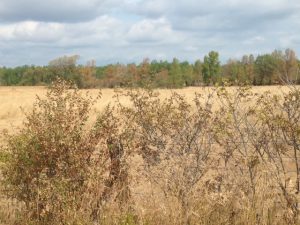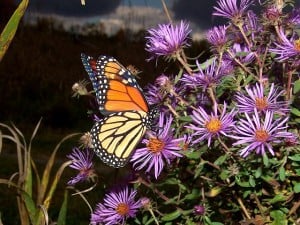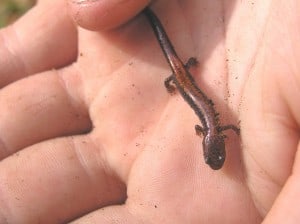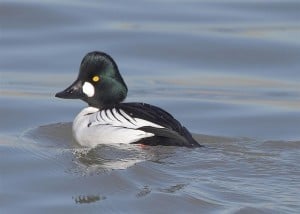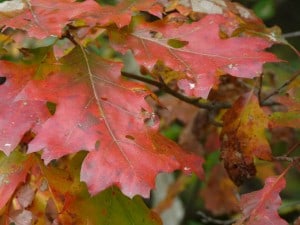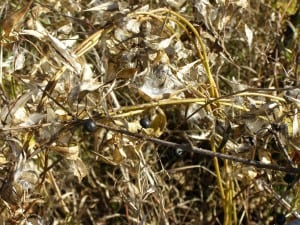Looking back at the summer of 2016, two words come immediately come to mind: drought and heat. August was a whopping 3.7 C warmer than the 1971-2000 average, while as of this week, September is about 3 C above normal temperatures. As for precipitation, July only saw one-third of normal rainfall. Precipitation was heavier in August but still only about half of what our region usually receives.
The combination of drought and intense heat was hard on our flora and fauna. Entire fields turned a ubiquitous brown, which meant that butterflies struggled to find nectar and healthy plants to lay eggs on. Monarchs may have been especially hard hit as only a handful of sightings were reported over most of the summer. Numbers have increased somewhat in recent weeks, however. On September 5, for example, I had three monarchs visiting my garden together. According to Dr. Chip Taylor of Monarch Watch, the continent-wide data to this point suggest that this year will be a repeat of 2014 with a significant decline in both migration and overwintering numbers.
The drought has also resulted in a number of trees changing colour and/or shedding leaves much earlier than usual. Oaks growing in the thin soils northern Peterborough County have suffered with many trees turning a sickly shade of brown. Most should be able to recover, however, as long as precipitation levels return to normal this fall and over the coming winter and spring.
The drought has also been hard on birds and other animals as fewer young have been able to survive. A lack of nuts and berries, for example, is proving difficult for bears, which may result in more conflicts with humans as they search for food. Lower water levels and increased water temperatures have been hard on fish, too, especially cold-water species like brook trout. As water levels dropped in wetlands, frogs were more vulnerable to predators such as herons and raccoons, while some turtles were forced to roam widely afield in search of appropriate habitat. It’s likely that many did not survive the journey.
In other news this summer, a new species of butterfly was recorded for Peterborough County. On June 21, Jerry Ball and Ken Morrison found a female pipevine swallowtail on Sandy Lake Road, off Highway 46 north of Havelock. This species is usually restricted to the Carolinian zone of southwestern Ontario. With climate change, more and more butterflies are extending their range northward. The giant swallowtail is a well-known example.
The common loons that nested on the Otonabee River, just north of Lock 25, appear to have been successful in raising their two young. On August 19, Dave Milsom observed and photographed the two juvenile loons with an adult. The young loons were constantly flapping their wings in preparation for their first flight.
There was also encouraging news regarding chimney swifts, a species at risk in Ontario. In a citizen science monitoring program known as Swift Watch, Dan Williams observed 123 swifts entering a chimney behind Wildrock on Charlotte Street. On June 6, Ariel Lenske saw 83 birds fly into the same roost, where they spend the night.
Finally, Loggerhead Marsh, located on Ireland Drive in west-end Peterborough, has just been classified as a provincially significant wetland. This designation normally means that no structures can be built within a 120 m buffer zone bordering the wetland. This is welcome news for such a rich and easily accessible nature-viewing destination.
As the autumn equinox quickly approaches, here is a list of events in nature that are typical of fall in the Kawarthas. If the mild weather continues, however, some events may occur later than usual. Not surprisingly, this has become the norm as climate change tightens its grip.
Late September
- Fall songbird migration is in full swing. Migrants such as warblers are often in mixed flocks with chickadees and can be coaxed in for close-up views by using “pishing”. To see and hear this birding technique in action, go to http://bit.ly/2cpznE8
- Broad-winged hawks migrate south over the Kawarthas in mid-September, especially on sunny days with cumulous clouds and northwest winds. Watch for high-altitude “kettles”, which is a group of hawks soaring and circling in the sky. For your best chance of seeing this phenomenon, consider a trip to Cranberry Marsh, located on Halls Road at the Lynde Shores Conservation Area in Whitby. Expert hawk watchers are on hand each day. Thousands of broad-wings pass over this area in mid-month every year.
- Peterborough Field Naturalists hold their Sunday Morning Nature Walks this month and next. Meet at the Riverview Park and Zoo parking lot at 8 am and bring binoculars. For more information, go to peterboroughnature.org
- As the goldenrods begin to fade, asters take centre stage. The white flowers of heath and calico asters, along with the purple and mauve blossoms of New England and heart-leaved asters provide much of the show. Visit ontariowildflowers.com for tips on identifying these beautiful but under appreciated plants.
- Listen for the constant calling of blue jays and the metronome-like “chuck-chuck…” call of chipmunks. The call is often given in response to danger such as the presence of a hawk. Chipmunk numbers are high this year, partly because of a strong acorn crop last fall, which allowed most of these small squirrels to overwinter successfully and have large litters.
October
- Fall colours in the Kawarthas usually peak early in the month. However, because of the hot, dry weather this summer, leaf colour is expected to be more muted than usual. County Roads 620 and 504 around Chandos Lake east of Apsley makes for a great colour drive.
- Sparrow migration takes centre stage, making October one of the busiest times of the year for backyard feeders. Scatter millet or finch mix on the ground to attract dark-eyed juncos and both white-throated and white-crowned sparrows.
- On October 12, Mike McMurtry, a recently retired ecologist from the Natural Heritage Information Centre, will be speaking to the Peterborough Field Naturalists on “Learning the Plants of the Kawarthas”. The talk will provide tips for identification and conclude with a quiz. The presentation begins at 7:30 pm at the Camp Kawartha Environment Centre on Pioneer Road. Everyone is welcome.
- Fall is a great time to find salamanders. The red-backed, which is almost worm-like in appearance, is usually the most common. Look carefully under flat rocks, old boards, and logs in damp wooded areas and around cottages.
- A tide of yellow spreads across the landscape in mid- through late October. The colour is supplied courtesy of trembling and bigtooth aspens, balsam poplar, silver maple, white birch, and, at month’s end, tamarack.
- As ducks move southward, consider a visit to the Lakefield sewage lagoons, which are located on County Road 33, just south of Lakefield. Just be careful to avoid blocking the gate when you park. Goldeneye, buffleheads, scaup and mergansers are often present in large numbers. If you have a spotting scope, be sure to take it along.
- If you find a Halloween bat in your house, it is probably a big brown. This species often overwinters in buildings. Little browns, on the other hand, choose caves and abandoned mines as winter quarters. Their population is in a free-fall because of White Nose Syndrome. Big browns are less susceptible to the disease.
- The first northern finches usually start turning up in late October. To learn which species to expect this fall and winter, Google “winter finch forecast 2016-2017”. The forecast, compiled by Ron Pittaway, is usually available online by early October.
November
- Oaks, tamaracks and silver maples are about the only native deciduous trees that still retain foliage in early November. The brownish-orange to burgundy leaves of red oaks stand out with particular prominence. At a glance, you can see just how common oaks are in many areas of the Kawarthas.
- We return to Standard Time on November 5th and turn our clocks back one hour. Sunrise on the 5th is at 7:56 am and sunset at 5:57 pm for a total of only 10 hours of daylight. Compare this to the 15 1/2 hours we enjoyed back in June!
- The red berries of wetland species like winterberry holly and high-bush cranberry provide some much needed November colour.
- Most of our loons and robins head south this month. However, small numbers of robins regularly overwinter in the Kawarthas. Their numbers should be particularly high this year, thanks to a plentiful wild grape crop. Grapes are a staple food for winter robins.
- Ball-like swellings known as galls are easy to see on the stems of goldenrods. If you open the gall with a knife, you will find the small, white larva of the goldenrod gall fly inside. In the spring, it will emerge as an adult fly.
- Damp, decomposing leaves on the forest floor scent the November air.
- With the onset of cold temperatures, wood frogs, gray treefrogs, chorus frogs, and spring peepers take shelter in the leaf litter of the forest floor and literally become small blocks of amphibian ice. Glycerol, acting as an antifreeze, inhibits freezing within the frogs’ cells.
I would like to thank Martin and Kathy Parker, Tim Dyson, Cathy Dueck and Jacob Rodenburg for having done such an admirable job filling in for me this summer. We are fortunate in the Kawarthas to have so many people with extensive knowledge of the natural world.
